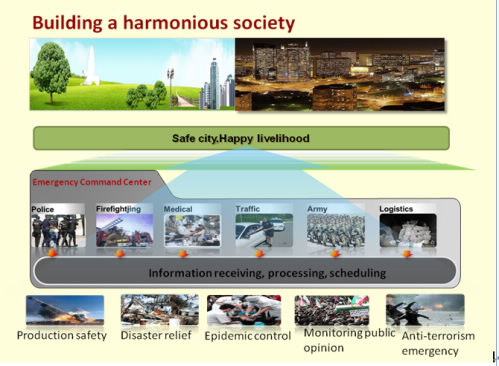The data-centric solution incorporates a video monitoring system, unified communications system, command and dispatch system, field command and dispatch system, and core processing platform based on data centers. Huawei emergency command platform sends massive information in these information collection platforms, such as video monitors, sensors, information capturers, to the core processing platform over wireless cluster and IP network. The core processing platform can quickly analyze the on-site situation, identify risks, and provide support for on-site decision-making by using intelligent analysis and model recognition technologies. Predicting pre-warnings and quick processing are key capabilities of the emergency command system, while quick processing for massive information and intelligent decision-making support are highlights of this system.

- l Huawei improves previous service processes to establish a comprehensive, intelligent, and quickly responsive emergency command platform. The platform integrates advanced technologies, such as cloud computing, cloud storage, desktop cloud, massive data analysis, and intelligent analysis.
- l The platform is a unified cooperation platform based on desktop cloud. It supports the access of various terminals to ensure that users access the platform, report and obtain the latest information promptly. Moreover, the platform is applicable to various scenarios, such as call centers, command centers, and mobile office access.
- l The cloud platform developed by Huawei supports this solution on resources, improves previous separate and isolated status, and integrates resources. All data sharing and exchange platforms developed by Huawei lay a solid foundation for resources and information sharing and interconnection among systems, and ensure efficient policing, fire protection, and emergency aid.
- l The design of the emergency command system complies with security level protection standards and rules on hierarchical protection and in-depth defense and ensures end-to-end system security by these methods, such as user authentication, data transmission encryption, data storage encryption, network isolation, access control, and system security.
- l Huawei effectively prevents single point of failure (SPOF) by using distributed technology and provides redundancy for all devices, key service modules, and links. The HA and live migration of VMs further ensures the carrier-class reliability and the 24/7 running of the emergency command system. Huawei also provides backup and disaster recovery solutions.
- l Huawei emergency command system is built based on the cloud platform developed by Huawei, implements resources sharing, and provides massive computing capability by constructing a resource pool. Moreover, the system can allocate resources elastically based on the emergency requirements to ensure the efficient use of the resources. The platform and system are decoupled and independent during resource expansion and reduction. This ensures that the resources required by the system are supplied quickly and service rollout is implemented rapidly.

